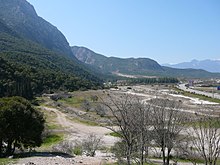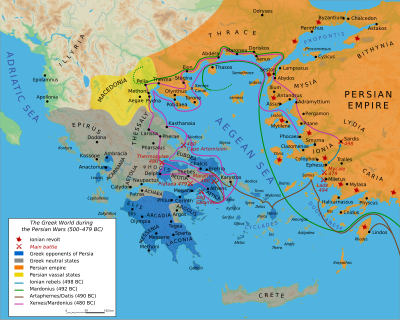Battle of Thermopylae
The Battle of Thermopylae, 480 BC,[5] was a battle in the second Persian invasion of Greece.[6] It was fought between an alliance of Greek city-states, led by Sparta, and the Persian Empire of Xerxes I. It took place at the pass of Thermopylae.[7] The battle was fought for over three days, at the same time as the naval Battle of Artemisium.[8]
| Battle of Thermopylae | |||||||||
|---|---|---|---|---|---|---|---|---|---|
| Part of the Greco-Persian Wars | |||||||||
 The site of the battle today: the road to the right is built on reclaimed land and approximates the 480 BC shoreline. | |||||||||
| |||||||||
| Belligerents | |||||||||
| Greek city-states | Persian Empire | ||||||||
| Commanders and leaders | |||||||||
|
Leonidas I †, Demophilus † |
Xerxes I of Persia, Mardonius, Hydarnes | ||||||||
| Strength | |||||||||
|
Total 5,200+ (Herodotus) 7,400+ (Diodorus) 11,200 (Pausanias) |
Total 2,600,000 (Herodotus)[3] ~800,000 (Ctesias) 70,000–300,000 (modern estimates)b[›] | ||||||||
| Casualties and losses | |||||||||
| 1,000 to 4,000 (Herodotus)[3] | ~20,000 (Herodotus)[4] | ||||||||

Context change
The Persian invasion was a delayed response to the defeat of the first Persian invasion of Greece. In 500 BC the lonians settled in the western coast of Asia minor and rose up against Persian’s King Darius. After six years, the rebellion was ended. In 490 BC the Persians sailed to punish the Athens. Darius fought against Athens and promised to punish them because they went to Persian land to help The Ionians.[9] This First Persian War was ended by the Athenian victory at the Battle of Marathon.
The preparation change
Xerxes had a huge army and navy, and in this Second Persian War set out to conquer all of Greece.[10]
The Athenian general Themistocles suggested the Greek allies should block the Persian army at the pass of Thermopylae, and block the Persian navy at the Straits of Artemisium.
A Greek force of about 7,000 men marched north to block the pass in the summer of 480 BC. The huge Persian army arrived at the pass in late August or early September.
The battle change
Heavily outnumbered, the Greeks held off the Persians for seven days in total (including three of battle), before the rearguard was annihilated in one of history's most famous last stands.
During two full days of battle, the small force led by King Leonidas I of Sparta blocked the only road by which the massive Persian army could pass. After the second day of battle, a local resident named Ephialtes betrayed the Greeks by revealing a small path that led behind the Greek lines. Aware that his force was being outflanked, Leonidas dismissed the bulk of the Greek army, and remained to guard the rear with 300 Spartans, 700 Thespians (who refused to leave), 400 Thebans and perhaps a few hundred others. Most of them were killed.
The pass at Thermopylae was thus opened to the Persian army according to Herodotus, at the cost to the Persians of up to 20,000 fatalities.[4] The Greek rearguard meanwhile, was annihilated, with a probable loss of 2,000 men, including those killed on the first two days of battle.[11][12]
change
After this engagement, the Greek navy at Artemisium received news of the defeat at Thermopylae. Since their strategy required both Thermopylae and Artemisium to be held, and given their losses, the Greek navy decided to withdraw to Salamis. The Persians then captured the evacuated Athens. During the battle the Greek navy lured the Persians into a narrow pass and obliterated at least 200 Persian war ships, thanks to Themistocles.
Seeking a decisive victory over the Allied fleet, the Persian fleet attacked, but were defeated at the Battle of Salamis in late 480 BC. Fearing to be trapped in Europe, Xerxes withdrew with much of his army to Asia, leaving Mardonius to complete the conquest of Greece. The following year, however, saw a Greek army decisively defeat the Persians at the Battle of Plataea, thereby ending the Persian invasion.
Both ancient and modern writers have used the Battle of Thermopylae as an example of the power of a patriotic army of freemen defending native soil. The performance of the defenders at the battle of Thermopylae is also used as an example of the advantages of training, equipment, and good use of terrain as force multipliers and has become a symbol of courage against overwhelming odds.
Related pages change
- The 300 Spartans (movie)
References change
- ↑ John Lemprière, A Classical Dictionary Containing a Copious Account of all the Proper Names Mentioned in Ancient Authors (London: 1863), p. 10
- ↑ Edward Greswell, Origines Kalendariæ Hellenicæ (Oxford, University Press, 1862), p. 374
- ↑ 3.0 3.1 Herodotus, with an English translation, ed. A. D. Godley (Cambridge, Harvard University Press, 1920) Book VIII, p. 25
- ↑ 4.0 4.1 Herodotus, with an English translation, ed. A. D. Godley (Cambridge, Harvard University Press, 1920) Book VIII, p. 24
- ↑ pronounced /θərˈmɒpɨliː/, thər-MOP-i-lee; Greek: Μάχη τῶν Θερμοπυλῶν, Machē tōn Thermopylōn
- ↑ Iggulden, Hal; Iggulden, Conn (2007). "Famous Battles – Part One: 1. Thermopylae 480 BC". The Dangerous Book for Boys. New York: HarperCollins. pp. 53–54. ISBN 978-0061243585.
- ↑ means 'The Hot Gates'
- ↑ Herodotus; Robin Waterfield; Carolyn Dewald The Histories (Oxford; New York: Oxford University Press, 2008), p. 712
- ↑ "Greco-Persian Wars: Xerxes' Invasion | HistoryNet". www.historynet.com. Retrieved 2018-03-13.
- ↑ Craig Sodaro, The Dangerous, Disastrous, Unusual History of War (North Mankato, MN: Capstone Press, 2012), p. 10
- ↑ Tom Holland, Persian fire: the first world empire and the battle for the West (New York: Doubleday, 2006), p. 397. ISBN 0385513119
- ↑ J.F. Lazenby, The defence of Greece 490–479 BC (Aris & Phillips, 1993), p. 148 ISBN 0-85668-591-7